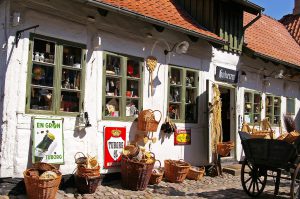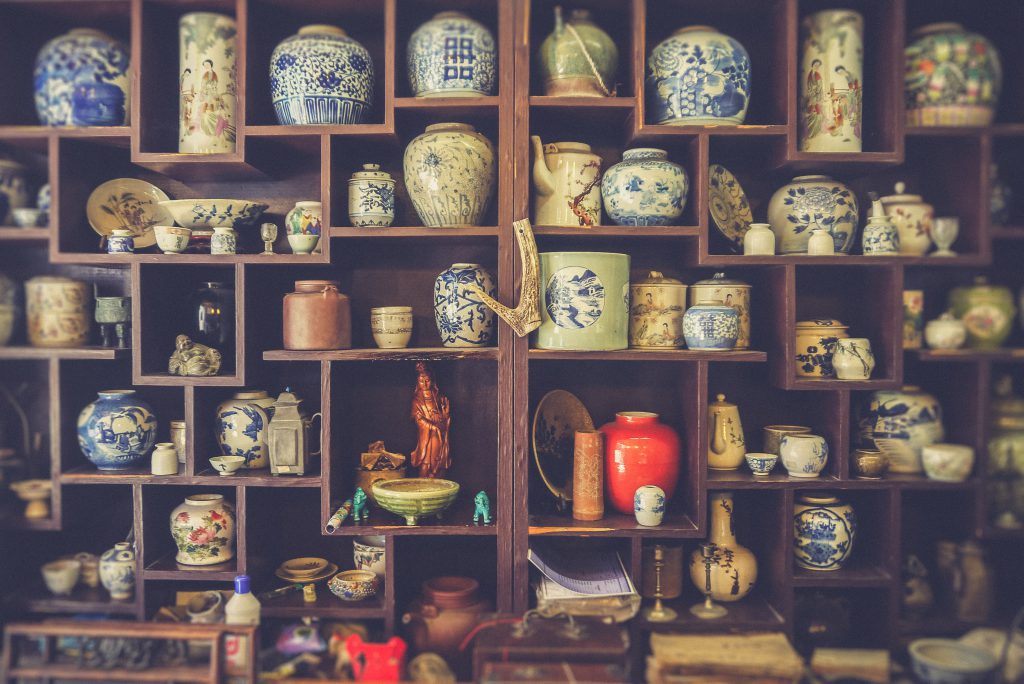
Are you someone who loves all things vintage? Do you often browse antique shops and flea markets, dreaming of owning your own antique business?
Starting an antique business could be a lucrative opportunity for you. In this article, we’ll guide you through the steps required to turn your passion for antiques into a successful business. From sourcing inventory to legal requirements, we’ve got you covered.
So, grab a cup of tea, put on your favorite vintage record, and begin your journey to becoming the ultimate antique aficionado!
Different Ways to Start an Antique Business

When it comes to starting an antique business, there are a variety of paths you can take to make your mark in the industry.
Below, we explain three popular options: online antique stores, physical antique shops, and pop-up shops or antique shows.
A physical store requires inventory, a good location, and effective marketing to attract customers. Online businesses need a website with secure payment methods and shipping options. Pop-up shops and antique booths offer flexibility and require less investment but still require effective marketing and good networking to attract customers.
Each option has benefits and drawbacks, so consider your resources and target audience to determine the best approach for your antique business. Let’s review each option more in-depth, focusing on the requirements and challenges associated with each option.
Online Antiques Business
Starting an online antique business is a fantastic option for those who want to operate from the comfort of their own home and reach a global audience. But let’s not sugarcoat it — succeeding with an online antiques business is challenging. You can choose between creating your website or selling on established marketplaces.
One of the main benefits of creating an independent website to sell antiques is the ability to control the branding and design of your business. This will help establish a unique identity and attract customers drawn to your specific style and offerings. Still, you’ll need an engaging and user-friendly website that showcases your items and makes purchasing easy for customers. Platforms like Shopify and WordPress offer easy-to-use templates and integrations to help create a professional and functional online store.
And speaking of showcasing your items, product photography is key! Ensure each item is displayed in the best possible light to entice potential customers.
One of the drawbacks of selling on an independent website is the difficulty in reaching the right audience. It’s challenging to drive traffic to a new website and build a customer base from scratch. Effective marketing strategies such as social media promotion, email marketing, and search engine optimization (SEO) are essential for any online business.
Alternatively, selling on online marketplaces such as eBay and Etsy offers the benefits of an established customer base and easy access to a large audience. These marketplaces have a strong reputation and built-in trust with customers, making it easier to make sales.
However, there is also fierce competition among sellers.
With so many online antique dealers, you’ll need to offer something unique to stand out. Also, advertising and collaborations with antique dealers or influencers are needed.
Physical Storefront

Opening a physical storefront is an excellent way to showcase your unique collection and create a one-of-a-kind shopping experience for your customers.
Picture a cozy storefront with charming window displays that catch the eye of every passerby. Once inside, shoppers may lose themselves in the beautiful world of antique delights. They’re also able to see each piece in person and inspect it properly.
Plus, if your store is in a bustling area with high foot traffic, you have the potential to attract antique lovers far and wide.
Opening a physical antique store requires a large investment in inventory and a great location. Moreover, you’ll also need resources to create an inviting atmosphere, with perfect lighting and displays to make the antiques shine.
And let’s not forget to factor in the resources for effective marketing strategies to get customers through the door.
So, how do you attract customers to your physical location?
We all know social media is king, so don’t forget to snap high-quality photos of your unique antique pieces and post them on Instagram, Facebook, and Twitter. Local advertising in newspapers or magazines is also a great way to spread the word about your store, but don’t stop there!
Why not sponsor a local event or host in-store events, like workshops, book signings, or auctions? Make use of word-of-mouth marketing as well. Offer referral discounts to your satisfied customers.
Pop-up Shops and Antique Shows
Pop-up shops and antique shows may be the right step for you. These temporary events are like a playground for antique lovers, a place to showcase your unique inventory and connect with potential customers without a long-term lease commitment.
Plus, you never know who’ll stumble upon your booth and fall in love with that one-of-a-kind piece you’ve been holding onto.
Pop-up shops and antique booths at events are also excellent ways to generate sales for established online antique businesses.
The pop-up shops rent a space temporarily while selling during shows involves setting up an antique booth or table at a larger event. These options require less investment in inventory and location but still require effective marketing and advertising to attract customers.
When it comes to pop-up shops, one of the biggest benefits is the flexibility to move locations and experiment with different markets. However, securing a location that will attract foot traffic and has a built-in customer base is challenging. Marketing efforts include flyers and signage, social media promotion, and partnering with other local businesses to cross-promote.
For antique shows, choosing the right events that align with your target market and the type of antiques you’re selling is vital. This includes researching the event’s attendance demographics and ensuring a sufficient demand for the antiques you plan to bring. Additional efforts include advertising in event programs, social media promotion, and offering exclusive deals or discounts to event attendees.
Both pop-up shops and antique shows can be a great way to test the waters before investing in a physical store or expanding your online presence. However, they may not be the best approach for people who plan to live off the business because they’re seasonal and unpredictable.
Steps You Need to Take to Start an Antique Business

Once you have decided how you want to start your antique business, there are several steps to take, starting with finding the right customer base and making a business plan.
Determine Your Niche
The journey begins with finding your particular niche. Are you a furniture fanatic, an art admirer, or a collector connoisseur? The choice is yours, but you must have a specific target in mind before doing anything else. The right niche balances your interests, market demands, and current trends.
Once you’ve picked your niche, it’s time to do research. Discover what’s hot and not in your chosen antique market niche, pinpoint the most profitable trends, and discover how to sell to your target audience.
Develop a Business Plan
After your antique niche is locked down, it’s time to start with business planning! This step is where the real fun begins. First, you’ll need to create a business plan covering all the essentials. We’re talking budgeting, marketing, and sales strategies.
Then, you’ll need to map out how you plan to source your one-of-a-kind inventory, come up with pricing that’ll have your customers flocking to you like bees to honey, and craft an epic marketing plan to get your business to the doorsteps of your target audience.
If you’re starting an antique business and need help creating a business plan, several resources are available to you.
SCORE is a nonprofit organization that offers free resources and mentorship to small business owners, including templates and guides for business planning.
The Small Business Administration (SBA) also provides a wide range of resources, including a guide to writing a business plan and free business planning tools and templates.
Finally, Bplans is a website offering free business plan templates and guides, while LivePlan is a paid business planning software offering more comprehensive templates and guides.
Source Your Inventory

When we say sourcing your inventory, we’re talking about finding the crème de la crème of antique treasures, those one-of-a-kind, top-notch goodies that will make your customers go wild and keep coming back for more. And trust us, there’s no shortage of ways to get your hands on these antique items.
Start by hitting up auctions and estate sales, where you can scour through dusty old attics and basements to uncover hidden gems that will make your heart skip a beat.
Or, why not check out some flea markets and swap meets where you barter and haggle for unique finds that’ll help your antique store beat the competition?
Building relationships with antique dealers and collectors is crucial to sourcing the best inventory. They usually have insider knowledge on where to find rare and valuable pieces that you wouldn’t be able to get your hands on otherwise. Plus, networking with fellow antique enthusiasts is always a blast. And building long-lasting relationships with antique dealers will help you get better prices and profit margins.
Price Your Inventory

When starting an antique or any business, pricing your inventory is a make-or-break step. It’s the difference between making a bank or going bust.
First, you have to determine each item’s exact market value. To do this, consider its condition, rarity, and historical significance because some pieces are worth more than others.
You also need to think about your target market and the prices they’re willing to pay. Are you catering to the high-end collectors or the bargain hunters? Because that’ll affect your pricing strategy.
Here’s the tricky part — you need to price your items fairly and make a profit. So, don’t go overboard and charge an arm and a leg, but don’t sell yourself short, either. You must find that sweet spot where your customers are happy, and you’re bringing in the big bucks.
One popular method is to add up all the costs involved in acquiring, restoring, and displaying the antique. Typical expenses for antique dealers include the initial purchase price, restoration expenses, transportation costs, and the cost of showing off the item in the store.
Once all the costs are added up, antique dealers then set a reasonable profit margin on top of those expenses. A profit margin typically falls within 30% to 50% of the total cost. This range allows for some flexibility while ensuring the price isn’t too steep that it scares away potential buyers.
Market Your Business
So, you’ve sourced your inventory and priced your items — now what?
It’s time to leverage your marketing strategy to get those antique items flying off the shelves.
For this step, social media is your new best friend. Platforms like Facebook and Instagram are a goldmine for promoting your inventory and attracting customers. On these platforms, you’ll be able to showcase your most prized pieces, share your latest finds, and even run some snazzy giveaways to get people excited about your business.
But why stop there? Participating in local antique shows and events is another fantastic way to get your name out there and meet potential customers face-to-face. You can display your stuff, network with fellow antique specialists, and even score new inventory while selling your old antiques.
And don’t forget about good old-fashioned word of mouth. Your satisfied customers will gladly share the love and recommend your business to their friends and family. So, invest in positive customer experiences.
Build Relationships with Customers
Building relationships with your customers is crucial in the antique business. However, you want to be more than just an antique dealer. Instead, your goal should be to become a trusted advisor and a go-to source for everything antique.
So, how do you build this bond of trust?
First, you need to provide top-notch customer service. You want your customers to feel valued and appreciated and know they can count on you for all their antique needs.
Next, fair prices are a must. Nobody likes feeling ripped off, so ensure you’re transparent about the pricing and give your customers a fair deal.
And speaking of transparency, don’t be afraid to spill the beans on the condition and history of each item you sell. Customers appreciate honesty and knowledge, so share your expertise and help them make informed decisions.
Building relationships means going the extra mile. Send a thank-you note or a small gift with each purchase, follow up with your customers after the sale, and always be willing to answer any questions. You want to be the kind of business owner people rave about to their friends and family.
Stay Informed
As any seasoned dealer knows, the antique market is constantly changing. What’s hot one day might be cold as ice the next, so staying in the loop about current or upcoming trends, price shifts, and market demands is necessary.
Fortunately, there are plenty of ways to keep your finger on the market’s pulse. For instance, attending trade shows is a fantastic way to scope out the competition, see what’s new and exciting, and meet other like-minded collectors and dealers.
But what if you can’t make it to a trade show? No worries. Subscribing to industry publications is another excellent way to stay up-to-date. You’ll stay on top of the latest trends, pricing strategies, and insider tips and tricks from the experts’ mouths.
Finally, let’s not forget about networking. Building relationships with other antique dealers and collectors is a fantastic way to stay in the loop and share knowledge and expertise. Plus, it never hurts to have a few friends in the business who’ll give you the inside scoop on the hottest new pieces and trends.
Legal Requirements

If you’re thinking of starting your own antique business, there are a few legal hoops you’ll need to jump through first.
Here’s a rundown of the steps you’ll need to take to get your vintage venture up and running.
Register Your Business
To be a legit antique business owner, you must register with the state and obtain a business license. It may sound like a drag, but avoiding any legal hiccups down the road is worth it. Plus, your business will promote trustworthiness and authority in customers’ eyes.
Obtain any Necessary Permits and Licenses
Before selling those antique treasures, ensure you’re not breaking any laws. Depending on your location and what kind of antique goodies you’re peddling, you may need extra permits or licenses to keep things legit.
For example, if you want to sell antique guns in California, the Bureau of Alcohol, Tobacco, Firearms, and Explosives (ATF) requires that you obtain a Federal Firearms License (FFL). You’ll also need to comply with California state laws that regulate the sale of firearms, even if they’re antiques.
Collect and Remit Sales Tax
As an antique seller, you’ll need to collect and remit sales tax on your one-of-a-kind finds in most states. It’s not hard, but understand your state’s sales tax laws and have a system for collecting and remitting taxes on time.
Do Antique Stores Make Money?
We can’t give a straightforward “yes” answer but bear with us. Like any business, an antique store’s success depends on a few key things.
First, you must sell high-quality, sought-out items. Antique lovers want unique and rare finds, so offering high-quality items at reasonable prices will bring in more customers and generate more sales.
Location is also crucial. If your store is in a busy tourist spot or an area with high demand for antiques, you’ll likely make good money. In contrast, things won’t go easy if you’re in a niche with little demand or a secluded place.
Running an antique store can be pricey, too. Rent, utilities, staffing, and getting good inventory can all add up. And finding rare, unique antiques isn’t always easy.
Despite these challenges, plenty of antique stores make a profit. This is because they focus on quality, fair pricing, and excellent customer service. Examples of successful and popular antique stores include Hemswell Antique Centres, The Old Cinema, and David Skinner Antiques.
Typically, highly successful antique stores offer a wide range of services. For instance, many offer restoration or repair services, hold workshops or events, or sell things like home decor or vintage clothes.
Running a business has its risks, though. Economic changes, shifts in consumer tastes, and unexpected expenses can all hit hard. But you can make money selling antiques with a solid plan, focus on quality, and adaptability.
So, finding an answer to the question “how much profit can an antique store make?” is more complex than it seems.
Mistakes to Avoid

Here are some common mistakes to avoid when starting an antique business.
Not Conducting Thorough Market Research
Before you dive headfirst into launching your business, you must do your homework. That means digging into your target audience, checking out your competition, and scoping out the market.
Without your research, you might end up with a store nobody wants to buy from. Or, even worse, you could be trying to sell something everyone is already selling, leaving you struggling to stand out in an oversaturated market.
Underestimating Start-up Costs
Don’t jump into things without thinking about the costs involved. You still have to budget for website development, marketing, and stocking up on inventory. If you don’t plan ahead, you might find yourself in some serious financial hot water.
Neglecting Website Design and User Experience
Your website is the face of your business, and nobody wants a face that looks neglected and unwelcoming. So, make sure your website is alluring and user-friendly.
You have to make it easy for people to find what they’re looking for and make the buying process as simple as possible. No one wants to struggle through a clunky checkout process — it’s a total turn-off! So get those web design skills working and create a visually stunning site that’s easy to navigate and buy from.
Not Investing Enough Time and Resources in Marketing
Having a killer product or service is only half the battle! You also need to get out there and tell the world about it.
Time to flex those marketing muscles and show off what you’ve got! If you skimp on marketing, you could end up with tumbleweeds blowing through your store, and nobody wants that.
Put in the time and resources to get your name out there and ensure people know about your unique offerings. You’ll be raking in sales and basking in the glow of your newfound brand awareness in no time!
Ignoring Customer Feedback
Your customers are the bread and butter of your operation, and their feedback is a true goldmine. Listen to their requests and complaints and pay attention to their needs. Ignoring customer feedback is like sticking your head in the sand — not a good look. You’ll lose sales and leave a lot to be desired.
Failing to Comply with Legal Requirements
We know it’s not the most exciting thing in the world, but if you ignore the legal requirements, you could end up in boiling water.
We’re discussing legal and financial consequences that could hamper the dream of owning an antique business. Yeah, it’s a bit of a headache, but it’s way better than dealing with a legal and financial fallout down the line.
Pros of Starting an Antique Business

Let’s talk about the fun stuff — why starting an antique business is a great idea.
- Passionate customer base
Antique enthusiasts are a dedicated bunch. They’re passionate about the history and beauty of vintage items, so you’ll have a built-in customer base just itching to get their hands on your wares.
- Unique inventory
When it comes to antiques, those one-of-a-kind finds make things worthwhile. Selling rare and historically valuable items means you could increase your prices and generate more profits.
- Creative outlet
Starting an antique business is a creative and artistic process — you get to curate and design your inventory and store layout to reflect your personal style.
- Flexibility
Depending on your setup, you could have a flexible work schedule. You can work from home or set your own hours. That means you can run your business in a way that works best for you.
- Potential for High Profits
No one can guarantee financial success, but you can make a decent living if you have a good eye for quality antiques and know how to price them right. The potential for high profits is a significant perk of starting an antique business.
Cons of Starting an Antique Business
We must also talk about the not-so-great stuff when starting an antique business.
Here are some things to keep in mind.
- Difficult to source inventory
Finding valuable gems can be like finding a needle in a haystack! It’s tough to source high-quality and unique antiques consistently, so get ready to put in a lot of time and effort.
- High overhead costs
If you’re opening up a physical store, prepare to pay for extra expenses like rent and utilities. These expenses quickly add up, taking a big bite out of your profits.
- Limited customer base
Depending on where you set up shop, you might have difficulty finding customers interested in antiques. A narrow and limited customer base can make it tough to generate sales and keep things going from month to month.
- Competition
The competition is fierce in the antique niche. You’ll have to work hard to stand out from the other dealers and be a top player.
- Legal Requirements
For some, the legal stuff is the worst. But if you’re starting an antique business, you must follow all the rules and regulations. That means registering your business, getting necessary licenses and permits, and dealing with sales tax.
Conclusion
In conclusion, starting an antique business can be an exciting and rewarding venture for those passionate about vintage items.
While there may be challenges along the way, such as sourcing inventory and navigating legal requirements, the potential rewards are well worth the effort. The benefits of starting an antique business are endless, from having a dedicated and enthusiastic customer base to the opportunity to curate unique inventory and set your schedule.
So, if you’re ready to turn your love of antiques into a thriving business, go ahead and take the leap — who knows, you could be the next big thing in the antique world!

Leave a Reply